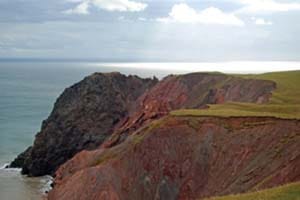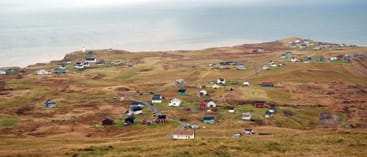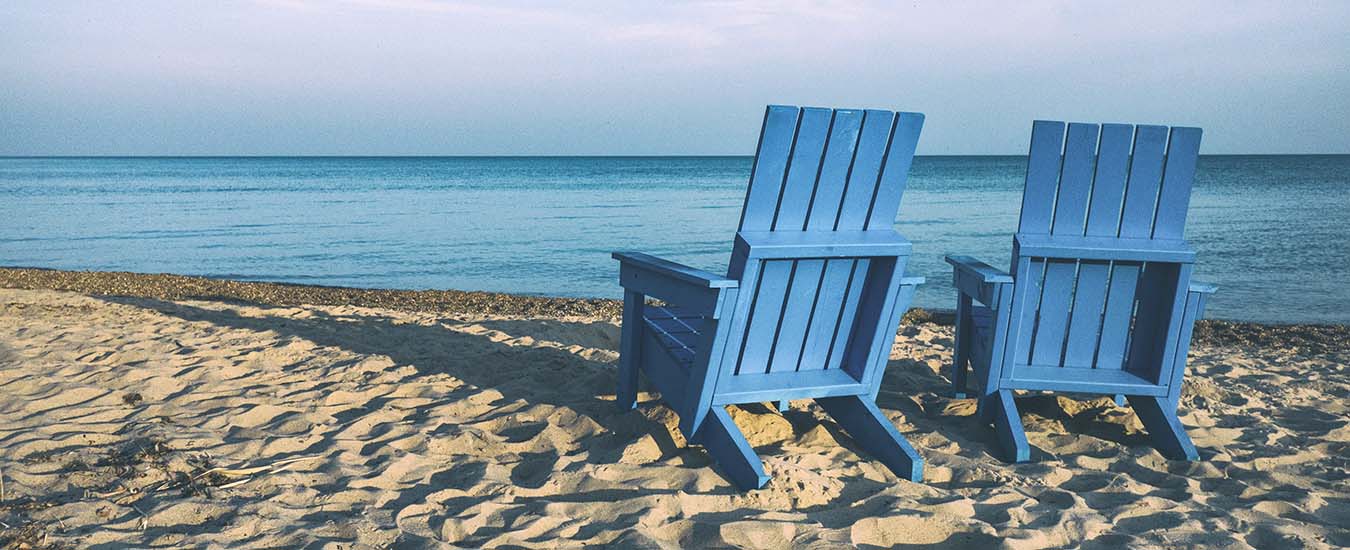At one time, many of the small islands that ring the coast of Atlantic Canada were thriving centres of the great east coast fishery where generations of hardy, self-sufficient islanders lived out their lives without feeling the need to ever leave for the mainland.
But recently, the allures of the outside world have become more compelling and connections to family and community correspondingly diminished. The result has been predictable. Outside Newfoundland, the number of these independent island communities remaining can be counted on one hand. Entry Island, one of the Îles de la Madeleine in the Gulf of St. Lawrence is one of them. This is a definite destination for those curious to know what life might have been like a hundred or more years ago-and who value uncrowded tranquility as a real vacation.

Entry Island is not only an anomaly in the sense of being an isolated community; it is also an English speaking community that has survived in a virtual sea of French. The Îles de la Madeleine has a population of more than 13,000 of which fewer than five per cent are anglophones. About 100 or so souls inhabit the island year round.
As might be expected, getting there requires some time and effort. The starting point is Souris, on the eastern tip of Prince Edward Island from where car ferries make the five-hour journey to Cap-aux-Meules the largest community on Îles de la Madeleine. All the island communities are connected by roads, bridges or sand , except Entry Island.
About four hours into the voyage from Souris the red and grey cliffs of Entry Island come into sight. The cliffs are large, sheer and streaked with hues that change with the position of the sun. Atop the cliffs is a green, pillowed canopy of meadows and wildflowers, unbroken by trees or shrubs. There is nary a sign of civilization, although an examination of the specks on the grassland reveals them to be cattle. The cliffs, air and water swarm with thousands of screeching seabirds. It is a sight that instills a need to stand on those green hills and look down on this magnificent panorama.
Passing Red Head, the cliffs diminish in size and gradually the low lying southern portion of the island comes into view. Scattered along the hillsides in a haphazard manner are some modest houses, a few farms, a church and other buildings. There is a wharf with colourful fishing boats at anchor. The ferry pushes on past-but you know you must go back.
Once on the Madeleines, you have three options. The first is to take an excursion that circumnavigates and then lands on the island. The advantage of this trip is that it provides a close-up view of the cliffs and the breeding seabird colonies from the water. The drawback is that the stop on the island is quite short, leaving time only for a snack at the restaurant or dairy bar, but no time to absorb the local colour. Alternatively you can take a day trip to the island that allows more than five hours on shore, which is enough time to climb Big Hill, the highest spot in the Îles de la Madeleine and perhaps visit the museum, but not enough to really get to know the place.
 The third option is to take the regularly scheduled ferry service on the M.V. Ivan Quinn, a brand new boat that goes to and from Entry Island twice each day. By this route you can set your own schedule and stay more than five hours or even overnight if you want. There is overnight accommodation, a restaurant and two stores. Camping is also possible.
The third option is to take the regularly scheduled ferry service on the M.V. Ivan Quinn, a brand new boat that goes to and from Entry Island twice each day. By this route you can set your own schedule and stay more than five hours or even overnight if you want. There is overnight accommodation, a restaurant and two stores. Camping is also possible.
An overnight stay or longer will allow enough time to really explore the island and get to know the very friendly islanders-who are happy to discuss their lifestyle and why they don't feel any sense of isolation or need to be in a bigger place. The wharf, restaurant or stores are great places to mingle. The museum provides some background as to where these English speakers came from and their proud contributions to both World Wars.
The overwhelming reason to come to Entry Island is however, to hike into those rare green hills first seen from the Souris ferry. Almost half the island is a dedicated community pasture which has a fence that runs completely across it. The locals will be happy to show or drive you to, the start of the trail which leads over the fence and on up to Big Hill. The hike is not particularly strenuous and the rewards outstanding-the best view in the entire archipelago, all the way to Cape Breton, almost 50 mÎles away.
From Big Hill you can wander freely up and down the gentle hills to the cliffs at Cap au Diable. Unconcerned livestock and a few horses graze contentedly in the pastures, and pose considerately for some great pastoral shots of green meadows, red cliffs and blue skies. From here it is a fantastic walk along the cliffs past the sea bird colonies to Black Head and eventually the fence.
Enchantment doesn't quite describe this tiny destination.

